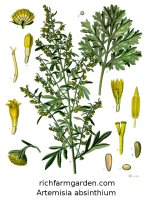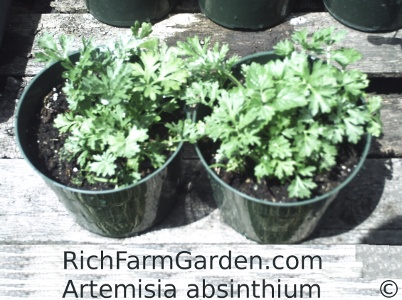
Absinthe plant
Ajenjo
Green ginger
Artemisia absinthium

| HOME --> All Plants and Seeds INDEX --> Herbs INDEX --> Wormwood Plants and Seeds | |
| Plant and Seed Mobile Friendly Index |
| |
|
|
|
 |
Absinthe plant Ajenjo Green ginger Artemisia absinthium |
 |
| #774 Packet $3.50 Approximately 50 seeds |
|
| #P774 Plant 3.5 inch pot $5.95 |
|
Known as Wormwood, Common wormwood, Grand wormwood and green ginger, Artemisia absinthium has a long history of use. It was well known in Roman and biblical times as a vermifuge and as a tonic for various complaints. Extremely bitter in taste and disliked by insects, wormwood became a metaphor to describe nearly anything acrid or unpleasant. ("...in the end she is as bitter as wormwood, as sharp as a two edged sword...")
|
To keep our carrots free of root flies, plant wormwood (Artemisia absinthium) as a companion. The bitter plant repels the little bugs. Members of the allium family (garlic, onions, and allium flowers) make great companion plants for members of the Brassica family (cabbage, kale, collards, broccoli, cauliflower). Also for tomatoes, peppers and carrots. They repel cabbage worms, root flies, aphids and slugs. To keep cabbage worms at bay, plant rosemary, dill, geraniums, nasturtiums or members of the Allium family (garlic, onions, and allium flowers) nearby. Cats aren't the only creature in nature to appreciate catnip. Beets love it, too. Catnip, along with mints and garlic can keep away pests. One of the best companion plants for peppers is ... MORE PEPPERS. Peppers are the self help vegetable. Fruits can be ground, fresh or dried and mixed with water to produce a natural pest repellent. You can also help keep your peppers producing by planting a dense growing herb like marjoram or basil in your pepper rows to shade the plants slightly and hold in humidity |